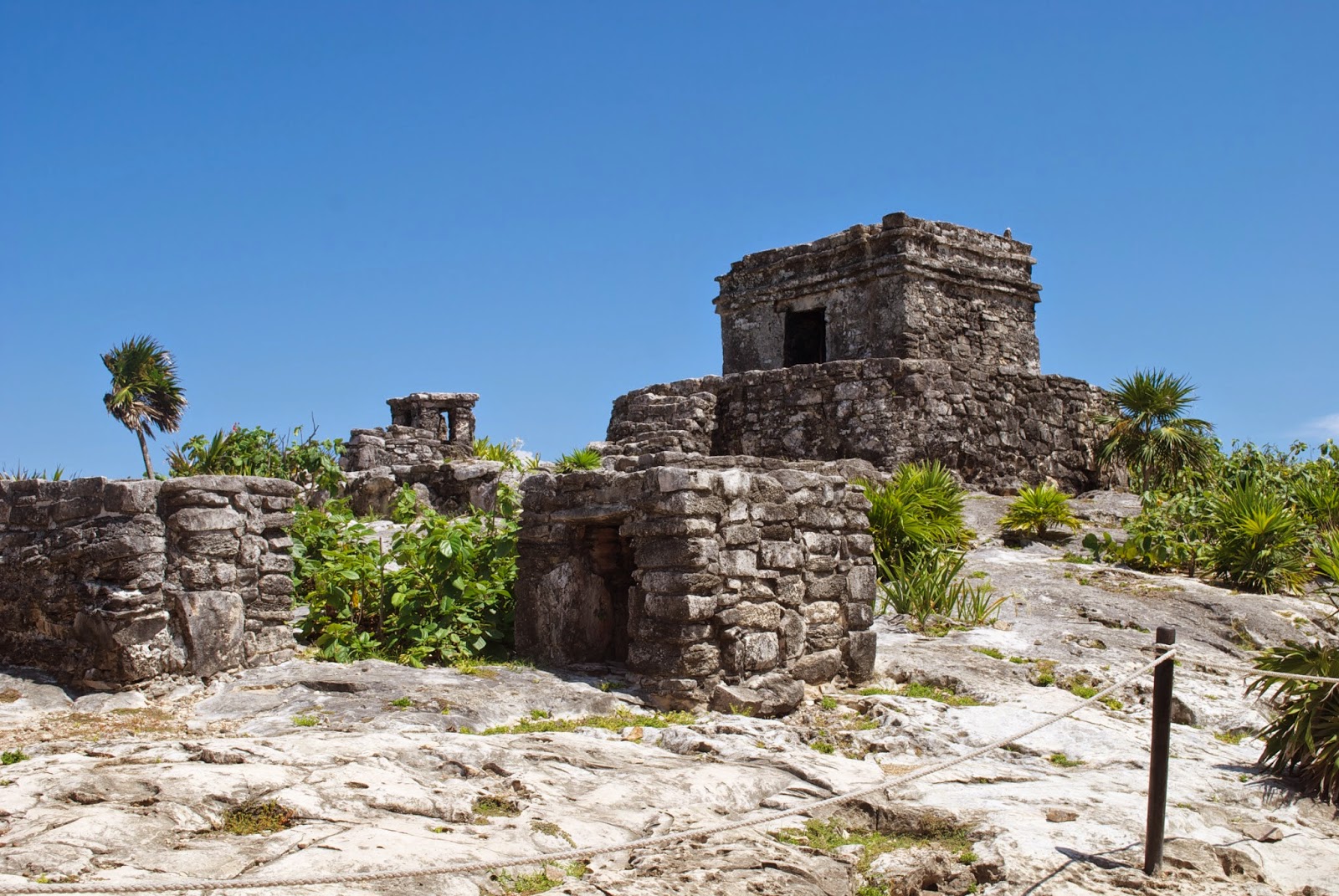The walk to the entrance of the ruins was a blistering one. With temperatures in the triple digits, I literally felt like I was melting away into the dirt. My face was dripping down into into my shirt and causing my cloths to be completely soaked.
The entrance was a stone wall with a short, rugged archway that looked more suitable for children than great ancestors. The Mayan people at the time were normally only about 5 foot tall so as we passed through the archway, we made sure to mind our heads. I walked through the entrance and the other side gave way to the spectacular remnants of the ancient Mayan city of Tulum.
The area was a large field that consisted of several stone buildings and temples. My guide, Juan, who was very passionate about Mayan history, gave me the history behind each building. Juan was originally born in this area and is one of the few left that can still speak the original Mayan language of this area. Needless to say, if he said something, I made it my business to listen carefully.
He pointed out first a small building on the cliff next to the ocean which in spanish is called “Templo del Viento” which translates to “House of the Wind.” This small structure was not only an observatory, but also was used as a meteorology tool. There is a small window in the building that faces the ocean. As the wind increases, the window creates a loud, piercing whistling sound. When the sound gets to a certain loudness, it was an indicator that a tropical storm or hurricane was approaching.
Next to the building was a smaller structure standing only about 4 feet tall with openings facing the east and another to the west. Originally archeologists thought that it was suppose to be a lighthouse to bring the sailors in by night; and this made sense since Tulum was thought to be a important fishing village. However, on June 21st 1996, one of the security guards that was monitoring the premises noticed something spectacular. At sunrise, the light from the sun gleamed into the east facing portion, and then out the west facing side which then glowed a bright crimson red. It was something so spectacular and unusual that the guard had to report it to the Archeological society and the following year, witnessed the same thing yet again. It is now believed that the structure was not a lighthouse at all but indeed one of the very first sundials ever created. Phenomena was created to indicate the summer solstice.
I followed Juan over to the next building which was called “Templo de los Frescos” This building had a great carving of a jaguars’ face depicted on the corners of the building. Originally these facades would have been brightly painted over but with time, the colors have faded almost completely. The etching can still be made out and efforts are made to try to preserve what is left.
The largest building on the whole premises and the most remarkable was “El Castillo”. This structure was a temple dedicated to the sun god. I walked over to it with sweat dripping and burning into my eyes. Looking up at the building was blinding from the sun now looking at me directly into my eyes. The awe of the building was almost enough for me to forget about the heat.
There were several large stone stairs which lead up to the temple its self. Inside, archeologists were originally stumped on what they found. Only a few frescos and clay pots; things that seemed to simple for such a large and dazzling temple. A few years later, an archeologists suggested that they were not excavating in the right places. What he suggested and what was eventually dug up and found was a second pyramid INSIDE of El Castillo. This was an exciting discovery and after years of excavation (which they are still doing to this day), they were able to find that second pyramid.
To the left of El Castillo was a smaller, peculiar looking building that is directly connected to El Castillo. This building they have named “Templo del Dios Descendente” which translated mean “Temple of the Descending God”. This room is interesting because of the small window that faces exactly 21º West. The interesting part of that figure and its direction is that the Ramses II statue in Egypt faces the same direction as well as other famous ancient structures. It makes it a mystery how several cultures separated by continents, oceans and time periods can find something significant in that direction.
Tulum was the very first Mayan society discovered by the Spanish conquerors in the 16th century and is also the only known walled Mayan city to exist on the sea shore. Behind El Castillo is the Caribbean Ocean. You can take a small staircase down to the sand where locals still come and bring their children to play in the surf. The real estate of the ruins seemed ideal for a successful city of any time period. Its no wonder why the mexican people still come here bask in the sunny seaside of Tulum.
The site was an exciting place to visit. To be walking in an abandoned city of such rich history and significance was enlightening. With the sun blistering onto the the top of my head, it made the experience seem like a wonderful hallucination. I look forward to exploring more ruins of the Mayans here on the Yucatan Peninsula. -DB












So lucky!
ReplyDelete